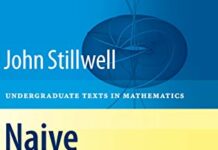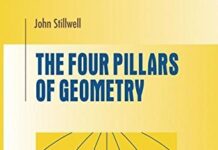
Ebook Info
- Published: 2018
- Number of pages: 200 pages
- Format: PDF
- File Size: 3.18 MB
- Authors: John Stillwell
Description
This book presents reverse mathematics to a general mathematical audience for the first time. Reverse mathematics is a new field that answers some old questions. In the two thousand years that mathematicians have been deriving theorems from axioms, it has often been asked: which axioms are needed to prove a given theorem? Only in the last two hundred years have some of these questions been answered, and only in the last forty years has a systematic approach been developed. In Reverse Mathematics, John Stillwell gives a representative view of this field, emphasizing basic analysis―finding the “right axioms” to prove fundamental theorems―and giving a novel approach to logic.Stillwell introduces reverse mathematics historically, describing the two developments that made reverse mathematics possible, both involving the idea of arithmetization. The first was the nineteenth-century project of arithmetizing analysis, which aimed to define all concepts of analysis in terms of natural numbers and sets of natural numbers. The second was the twentieth-century arithmetization of logic and computation. Thus arithmetic in some sense underlies analysis, logic, and computation. Reverse mathematics exploits this insight by viewing analysis as arithmetic extended by axioms about the existence of infinite sets. Remarkably, only a small number of axioms are needed for reverse mathematics, and, for each basic theorem of analysis, Stillwell finds the “right axiom” to prove it.By using a minimum of mathematical logic in a well-motivated way, Reverse Mathematics will engage advanced undergraduates and all mathematicians interested in the foundations of mathematics.
User’s Reviews
Editorial Reviews: Review “If you are not familiar with this relatively new research about the foundations and and minimal assumptions needed to develop the massive mathematical structure, this provides a good informal guideline.”—Adhemar Bultheel, European Mathematical Society”John Stillwell’s book gives a clear and engaging introduction to an intriguing area of mathematics: reverse mathematics.”—Martyn Prigmore, Mathematics Today”The book is rich in examples and historical perspectives, is clearly argued and immaculately presented.”—Graham Hoare, Mathematical Gazette Review “Reverse mathematics is the mathematical logician’s version of zoology or botany, a classification of mathematical theorems in terms of the strength of the axioms needed to prove them. Stillwell carefully situates the field in the broader context of the history of mathematics and its foundations, and does a fine job of making the whole endeavor accessible to a general mathematical audience.”―Jeremy Avigad, Carnegie Mellon University”Filling an important niche, this book gives readers a good picture of the basics of reverse mathematics while suggesting several directions for further reading and study. It provides a context for the questions investigated by reverse mathematics and makes an extended argument for their significance within contemporary mathematical practice.”―Denis Hirschfeldt, University of Chicago”Reverse mathematics is a major research direction in the foundations of mathematics and mathematical logic, and the insights obtained from reverse mathematics will interest a wide mathematically minded audience. Stillwell’s book is self-contained and includes much background material in analysis, mathematical logic, combinatorics, and computability. I heartily commend this very readable and accessible book.”―Stephen Simpson, Vanderbilt University From the Back Cover “Reverse mathematics is the mathematical logician’s version of zoology or botany, a classification of mathematical theorems in terms of the strength of the axioms needed to prove them. Stillwell carefully situates the field in the broader context of the history of mathematics and its foundations, and does a fine job of making the whole endeavor accessible to a general mathematical audience.”–Jeremy Avigad, Carnegie Mellon University”Filling an important niche, this book gives readers a good picture of the basics of reverse mathematics while suggesting several directions for further reading and study. It provides a context for the questions investigated by reverse mathematics and makes an extended argument for their significance within contemporary mathematical practice.”–Denis Hirschfeldt, University of Chicago”Reverse mathematics is a major research direction in the foundations of mathematics and mathematical logic, and the insights obtained from reverse mathematics will interest a wide mathematically minded audience. Stillwell’s book is self-contained and includes much background material in analysis, mathematical logic, combinatorics, and computability. I heartily commend this very readable and accessible book.”–Stephen Simpson, Vanderbilt University About the Author John Stillwell is professor of mathematics at the University of San Francisco and an affiliate of the School of Mathematical Sciences at Monash University, Australia. His many books include Mathematics and Its History and Elements of Mathematics: From Euclid to Gödel (Princeton). Read more
Reviews from Amazon users which were colected at the time this book was published on the website:
⭐No effort to bring casual math fans up to speed with the topic. I was lost after just a couple pages.
⭐This is not a beginners book. But if you have been down the road before it is brilliantly written. It is mathematics, but not overbearing.The author covers numbers, analysis, computability, the key elements of current day mathematics. He does so in a very readable manner focusing on reverse theory, namely looking at the results to see the assumptions. Hilbert and his Geometry was to some degree to me a similar task a century ago. But instead of being ponderous the author is succinct, clear, and understanding. I found the analysis section and interesting interpretation having spent time decades ago in the area.For anyone interested in a different view of mathematics this is an idea addition and very well worth the read. As another reviewer wrote, the first chapter is easy, the other challenging but well worth the effort.
⭐I found the “tree” approach a unifying and fresh approach to Proof Theory. Not enough background for the axiom of choice a la Hamos.
⭐A wonderful journey through math!
⭐The author describes this new area very well. A great introductory book. He starts with natural numbers and gets all the way to reals and set theory. I like the way he transitions from set theory to Godel and computation.
⭐The content is OK, but it is not formatted to read like other kindle books. In fact , you can’t even read it on the Kindle. It is readable on the PC but even that is awkward and kind of “flaky” because the controls can give inconsistent results. If you are serious about this book, I would recommend the hard copy. The Kindle version is just very annoyingly awkward.
⭐A gift that made his day!
⭐Awesome
⭐Like other reviewers, I thought the premise of this book was interesting and novel – I expected an exposition of the minimal set of axioms required for mathematics. Ultimately I think I did indeed get that. However, this book is most definitely not for the non-mathematical layman, although you don’t have to be a professional mathematician to appreciate it either. I learnt many new things and it helped give me better understanding (e.g. to the axiom of choice which I had touched on in a postgraduate physics degree when I attended a course on topology). I think if you have the equivalent of a good A level in maths and are prepared to read around the subjects in this book by consulting other books then you could get a lot out of it. I also liked that this book covers relatively recent research at times (e.g. one reference I noted was to a theory proved in the 1970s) that I haven’t seen tackled in other books (as another example, I had never come across the Weak König Lemma before).
⭐It was a gift for my husband who is still reading it but thinks it is worth buying.
⭐Interessante e, se letto con cognizione di causa, anche illuminante ma non sembra pensato se non per esperti del settore. Incomprensibile a chi è digiuno anche solo di logica matematica a livello universitario
⭐
⭐I’ll start with a word of caution : Stillwell’s statement that the book is “very much” for the non-specialist is highly optimistic !Quite the contrary, the reader needs to have been exposed to a serious dose of logic & set theories, in order to absorb Stillwell’s exposition : indeed, the author uses abundantly such theories — without prior explanations — in a deluge of axioms, definitions, dense and convoluted proofs of theorems… and in no apparent order/structure, i.e. it’s up to the reader to link and reason out Stillwell’s jumping around between the various systems of axioms, their corresponding equivalent theorems, all in a sometimes indigestible set-theoretic soup !Introducing Reverse Mathematics as an outcome of the fundamental findings of the quartet of great logicians — Gödel, Post,Turing & von Neumann — should have been a fabulous opportunity. Unfortunately, Stillwell’s book will probably be restricted to his peers and to those readers who can fetch in their logic library (*) in order to outguess Stillwell’s cryptic paragraphs …(*) See a proposed list of books, in my review of Kleene’s “Introduction to Metamathematics”.
⭐
⭐Very good introduction to reverse mathematics. Almost no prerequisites are assumed. I recommend this book.
Keywords
Free Download Reverse Mathematics: Proofs from the Inside Out in PDF format
Reverse Mathematics: Proofs from the Inside Out PDF Free Download
Download Reverse Mathematics: Proofs from the Inside Out 2018 PDF Free
Reverse Mathematics: Proofs from the Inside Out 2018 PDF Free Download
Download Reverse Mathematics: Proofs from the Inside Out PDF
Free Download Ebook Reverse Mathematics: Proofs from the Inside Out



